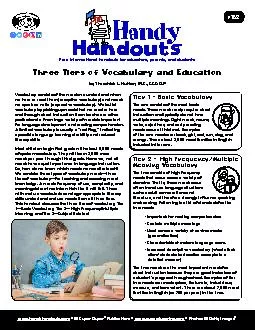/


Handy HandoutsNumber Three Tiers of Vocabulary and Education by Thaashida L Hutton MS CCCSLP Vocabulary consists of the words we understand when we hear or and words we speak or write We ID: 194916
Download Pdf The PPT/PDF document "2008 super duper publications 149 www su..." is the property of its rightful owner. Permission is granted to download and print the materials on this web site for personal, non-commercial use only, and to display it on your personal computer provided you do not modify the materials and that you retain all copyright notices contained in the materials. By downloading content from our website, you accept the terms of this agreement.
© 2008 Super Duper Publications • www.superduperinc.com Handy Handouts!Number Three Tiers of Vocabulary and Education by Thaashida L. Hutton, M.S., CCC-SLP Vocabulary consists of the words we understand when we hear or ) and words we speak or write (). We build vocabulary by picking up words that we read or hear and through direct instruction from teachers or other professionals. Knowing a variety of words is important for language development and reading comprehension. A limited vocabulary is usually a “red flag,” indicating a possible language learning disability and reduced literacy skills. Most children begin first grade with about 6,000 words of spoken vocabulary. They will learn 3,000 more words per year through third grade. However, not all words have equal importance in language instruction. So, how do we know which words we need to teach? We consider three types of vocabulary words—three tiers of vocabulary—for teaching and assessing word knowledge. A word’s frequency of use, complexity, and meaning determines into which tier it will fall. Those with mature vocabularies and age-appropriate literacy skills understand and use words from all three tiers. This handout discusses the three tiers of vocabulary, Tier 1—Basic Vocabulary, Tier 2—High Frequency/Multiple Meaning, and Tier 3—Subject Tier one consists of the most basic words. These words rarely require direct instruction and typically do not have multiple meanings. Sight words, nouns, verbs, adjectives, and early reading words occur at this level. Examples of tier one words are: book, girl, sad, run, dog,8,000 word families in English included in tier one. Tier two consists of high frequency words that occur across a variety of domains. That is, these words occur often in mature language situations such as adult conversations and literature, and therefore strongly influence speaking and reading. Following is a list of standards for tier two words: on • CharacteristicContain multiple meanings • Increased descriptients allow student(generalization) Tier 1—Basic Vocabulary Tier 2—High Frequency/Multiple Meaning Vocabulary © 2008 Super Duper Publications • www.superduperinc.com Tier two words are the most important words for direct instruction because they are good indicators ofmasterpiece, fortunate, industrious, families in English We usually learn these words when a specific need arises, such as learning amino acid during a economics, isotope, asphalt, Revolutionary The remaining 400,000 words in English fall in this tier. It important to remember thatpersonal experience. Students may struggle to increase vocabular lack of instruction. This may learning disability, or poor instruction. Under these situations, schools can administer a response to intervention program (RtI). RtI will then determiadditional instruction Resources Beck, Isabel L., McKeown, Margaret G., and Kucan, Linda. (2002). Bringing words to life. New York, NY: The Guilford Press Montgomery, Judy K. (2008). MAVA-Montgomery assessment of vocabulary acquisition. Greenville, South Carolina: Super Duper Publications, Inc. Montgomery, Judy K. (2007). Vocabulary Intervention for RTI: Tiers 1, 2, 3 Retrieved October 28, 2008, http://74.125.45.104/ search?q=cache:VjfiwE6PJYEJ:convention.asha.org/2007/ handouts/1137_1757Montgomery_Judy_106716_Nov05_2007_Time_122121AM.ppt+three+tiers+of+vocabulary&hl=en&ct=clnk& cd=6&gl=us 3 Tier vocabulary words. Retrieved October 28, 2008 http://t4.jordan.k12.ut.us/cbl/images/CBL_Documents/3tiervocab.pdf Tier 3—Low-Frequency, Context-Specific Vocabulary Students with Limited Vocabulary © 2008 Super Duper Publications • www.superduperinc.com Handy Handouts!Number The list of Super Duper® products below may be helpful when practicing or doing activities ent. Visit www.superduperinc.com the links below to see the product description. Core Curriculum Vocabulary Cards Level One Ask for Item #CRD44 http://www.superduperinc.com/products/view.aspx?pid=CRD44 Ask for Item #FD74 http://www.superduperinc.com/products/view.aspx?pid=FD74 Grannies Candies® The Delicious Game of Word Meanings Ask for Item #GB154 http://www.superduperinc.com/products/view.aspx?pid=GB154 MAVA Montgomery Assessment of Vocabulary Acquisition™ Ask for Item #MAVA22 http://www.superduperinc.com/products/view.aspx?pid=MAVA22 Ask for Item #BGO22 http://www.superduperinc.com/products/view.aspx?pid=BGO22 ion (RtI) Program for Reading Ask for Item #START11 http://www.superduperinc.com/products/view.aspx?pid=START22 Helpful Products